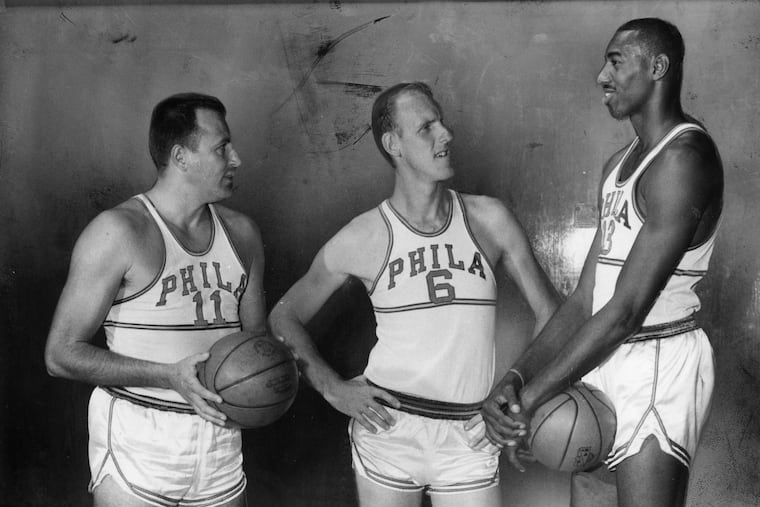Neil Johnston, Philadelphia’s forgotten Hall of Famer | Frank’s Place
"Neil Johnston truly is a forgotten legend," NBA blogger Drake Misek wrote in 2015.

Looking at photos of him now, 59 years after he retired, 40 years after he died, 28 years after he was posthumously inducted into the Basketball Hall of Fame, you begin to understand why almost no one remembers Neil Johnston.
Balding, lantern-jawed, awkward-appearing, the 6-foot-8 Philadelphia Warriors center looks no more like a basketball star in 2018 than he did in 1956.
A city currently abuzz over a 76ers revival has forgotten a player who was every bit as statistically dominant as Joel Embiid or Jimmy Butler.
So have diehard NBA fans. When a statistically savvy basketball blogger recently stumbled across his name high on the all-time player efficiency ratings – Michael Jordan was No. 1, LeBron James No. 2, Johnston No. 10 — he had to ask, "Who?"
Johnston's curious anonymity even has spread to the one place where you'd expect his legacy to endure, his little hometown in the Appalachian foothills, Chillicothe, Ohio.
Several years ago, while selling some Johnston memorabilia at an auction there, Bruce Caplinger, a local collector and sports historian, asked citizens what they knew about Johnston.
His questions were met by blank stares.
"People didn't know him," Caplinger said this past week. "A guy from Chillicothe who's in the Basketball Hall of Fame and people here never heard of him."
Seeking a way to educate and honor, Caplinger in 2016 announced plans to erect a Johnson statue in the city of 21,000 that is 45 miles south of Columbus.
So far, despite two fund-raisers, he's only halfway to his $50,000 goal.
"It's definitely a project that could use some help," he said.
So what happened? How does a player who during the 1950s led the Philadelphia Warriors to a championship, won three consecutive scoring titles, was a six-time all-star and four-time all-NBA first-teamer, fade so quickly, so thoroughly into the fog?
In part, it's because Johnson played before widespread TV coverage, lacked charisma, and looked like a geek. Maybe more significant, he played center just before Wilt Chamberlain and Bill Russell revolutionized the position and the sport.
"Neil Johnston truly is a forgotten legend," NBA blogger Drake Misek wrote in 2015. "For a player … to be so unknown when he's one of the top 10 most efficient players in NBA history and had a career comparable to many of the most acclaimed centers, seems like a disservice to the man's legacy."
An ungainly freshman basketball player at Chillicothe High, Johnston made himself into an all-state performer as a senior. A star baseball pitcher too, he left Ohio State after two years and signed with the Phillies – reportedly for the largest bonus ever given to a tryout-camp find.
Scouts labeled the lanky righthander "the second Ewell Blackwell." But in three seasons at Terre Haute and Wilmington, he was merely average.
"I had a fastball but no curve," Johnston explained in 1961. "I was all right for six innings, but then watch out. Boom!"
Realizing basketball might be an option, he arranged a 1951 meeting with Warriors owner/coach Eddie Gottlieb. Following a tryout at the team's Hershey training camp, he was given a contract.
Gottlieb saw promise in Johnston even though "it sometimes didn't look like his left leg knew where his right leg was going."
A deep sub as a rookie, he got his break in 1952-53, when Warriors star Paul Arizin went off to the Marines. That season he led the NBA in points (22.3), shooting percentage (.452), and minutes per game (45.2), beginning a streak of four straight appearances on the all-NBA first team, six straight on the All-Star team.
Johnston developed and honed a hook shot that was his era's sky-hook, a deadly and nearly unstoppable offensive weapon. He was first again in scoring and minutes in 1953-54, and first in scoring and rebounding the following season.
Those three scoring titles in succession are something only six other players — Jordan, Chamberlain, Kevin Durant, George Gervin, Bob McAdoo, and George Mikan – have accomplished.
In 1955-56, Johnston averaged 22.1 points and 12.5 rebounds as his Warriors won 45 games and captured their second and last title in Philadelphia.
Then during a 1958 preseason game in St. Louis, he injured a knee when he ran into a wall. By season's end, at age 30, he was through as a player.
Understandably fond of his now-idled star, Gottlieb hired him to coach the Warriors in what was Chamberlain's rookie season, 1958-59.
It was a toxic mix. For whatever reason, Chamberlain had no respect for Johnston, and the coach no patience for his superstar's enigmatic nature.
But if one was going to go, it wasn't going to be Chamberlain. The problem was solved in March 1961 when, despite a 95-59 record in two seasons, Johnston quit.
"I can't go on like this," he said. "It's better I quit now to save myself a lot of headaches and heartaches."
He hung around the game for the rest of his abbreviated life – an assistant to Jack McCloskey at Wake Forest and with the Portland Trail Blazers; head coach of the American Basketball League's Pittsburgh Rens and Eastern League's Wilmington Blue Bombers.
In 1978, while serving as the athletic director at North Lake College in Irving, Texas, he collapsed and died while playing basketball with his son Scott. He was 48.
"I've shown his photo to various doctors and when they see his elongated face and neck, they're all convinced he suffered from Marfan syndrome," said Caplinger, referring to the genetic disorder that most typically afflicts the hearts of unusually tall persons.
Twelve years after his death, the veteran's committee elected Johnston to basketball's hall.
His fellow 1990 inductees at Springfield were Earl Monroe, Dave Bing, and Elvin Hayes, three players who, unlike Neil Johnston, have never been forgotten.